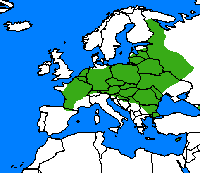Map butterfly
Several butterfly species may look slightly different between broods, but of all the European species, that's most dramatic in the Map butterfly Araschnia levana.
The first, spring brood is predominantly orange. This photo, a Map butterfly on cow parsley, is from the Dordogne in May 2012. Sexes are similar. The French name for the Map is, appropriately, carte géographique.

The summer brood of Maps is blacker and at first sight has similarities to white admiral. This photo, on ground elder, is in Babadag Forest in the Danube Delta in June 2014.
A Norfolk map
The Map butterfly isn't a British species (yet) but the Norfolk Branch of Butterfly Conservation (newsletter, autumn 2015) reports a sighting at a caravan park at Pentney in west Norfolk on 28 September 2015.
Andy Brazil, County Recorder, was impressed by the finder, N I Rix: "Resourcefully, he spotted a camper van with Dutch plates in the park, and on enquiry was told that yes, they had found a butterfly in the van which they had let out of the window.
"So we must presume that our Map had crossed by Eurotunnel — possibly the first butterfly ever to arrive under the Channel instead of over it!"
Andy confirms that this butterfly was a summer brood Map, as would be expected from the date, and that the finder first thought it was a white admiral but happily was alert enough to realise what he had found.
Other Honeyguide nature notes about butterflies
Monarch butterflies - Painted ladies - Glanville fritillary
Dordogne butterflies . . . . . . . . . . . . . . . . . . Honeyguide's Dordogne holiday



